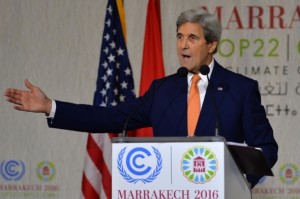US Secretary of State John Kerry delivers a speech at the COP22 climate change conference on November 16, 2016, in Marrakesh.
MARRAKECH, Morocco—The Obama administration fulfilled what is probably its final major contribution to the Paris Agreement yesterday, releasing an outline for how the United States can act in the long term to help the world keep warming to a safe level.
The midcentury deep decarbonization strategy, developed in collaboration with Canada and Mexico, envisions a future where the world’s largest economy transitions almost entirely to non-fossil-fuel energy sources for transportation and electricity, expands forests and continues to phase down non-carbon-dioxide greenhouse gases.
“This midcentury strategy is a demonstration of the United States’ commitment to the long-term goals and the long-term ambition embodied in the Paris Agreement,” said White House climate adviser Brian Deese.
The deal nearly 200 countries agreed to outside the French capital last year set a long-term goal of keeping warming to well below 2 degrees Celsius, with efforts toward a 1.5 C limit—targets that require the world’s emissions to reach net zero in the second half of this century. The agreement also mandated that by 2020 countries produce a vision for how they intend to get there.
The Obama administration has said it accelerated that process to provide other countries with a template for how to craft their own long-term pathways.
But another driver was almost certainly the possibility—and now the certainty—that Republican Donald Trump would succeed President Obama in the Oval Office. The president-elect has promised to cancel the Paris deal and would be unlikely to spend resources complying with it.
With Trump now headed for the White House, the sketch Deese introduced at a well-attended gathering at the U.S. Center in Marrakech appears fanciful. It imagines how the United States can make good on Obama’s pledge at the climate talks in Copenhagen, Denmark, in 2009 to slash U.S. emissions by more than 80 percent by midcentury through a suite of actions that would rely, at least in part, on policy signals the new administration seems very unlikely to support.
“By 2050, nearly all fossil fuel electricity production can be replaced by low carbon technologies, including renewables, nuclear, and fossil fuels or bioenergy combined with carbon capture, utilization and storage (CCUS),” the blueprint boldly states.
It also assumes advances in energy efficiency, a shift to non-fossil-fuel transportation technologies through policy and “rapidly scaling investment in low-carbon innovation,” the development of decarbonization technologies like carbon capture and storage that would depend upon public-sector support both in funding and regulation, and other measures. The document also suggests that the United States could roll back a third of the deforestation that has occurred in the last 160 years, though Deese said that trend is already in progress.
Mexico the Star at the U. S. Show
Deese released the paper at an event that also featured Stephen Lucas, Canada’s senior associate deputy minister for environment and climate change, and Rodolfo Lacy Tamayo, Mexico’s undersecretary for environmental policy and planning.
The three North American countries pledged to collaborate on their long-term strategies during the “Three Amigos” summit in Ottawa in June. While yesterday’s event still echoed the spirit of camaraderie that pervaded that meeting of the three heads of state, it was clear that the U.S. election result has had an impact.
Tamayo received some of the biggest applause reactions, as when he noted that Mexico’s legislature approved both Paris and its domestic climate legislation along broad bipartisan lines—a clear contrast to the situation in Washington, D.C.
And he took aim at Trump’s statements against his own country, especially Trump’s continued support for a barrier along the Mexican border. He noted that North America’s subnational governments can continue to make progress toward a continental carbon market in the coming years even though the United States will continue to lack a federal carbon price.
“It is feasible to build bridges and not walls, so let’s do it,” Tamayo told an appreciative audience.
The United States received kudos from advocates and delegates here for releasing its strategy despite the changing political landscape. But diplomats and activists alike emphasized that more action will be needed from the world’s second-largest emitter.
“The U.S. is showing important leadership by putting its midcentury deep decarbonization strategy on the table now,” said Rachel Cleetus of the Union of Concerned Scientists. But she said that “policies and actions” would be needed immediately to place the United States on a low-carbon trajectory toward 2050 and ensure that a costly course correction isn’t required in later years.
“For example, an overreliance on natural gas could leave us at risk of constructing expensive infrastructure that will quickly become obsolete,” she said.
The Sierra Club’s Steve Herz said environmentalists could make progress during the Trump years by pressing state and local governments to block fossil fuel projects that would lock in high-carbon infrastructure for decades to come. But he said market forces will help tilt the playing field toward renewables and efficiency over gas.
But Thoriq Ibrahim, environment minister for the Maldives and chairman of the Alliance of Small Island States negotiating group, said that while the document is appreciated, “what we need immediately are concrete actions.”
“Without them, some of us may be underwater by midcentury,” he added.
Scientific American has reprinted this article from ClimateWire with permission from E&E News.
See also: www.FrackCheckWV.net

